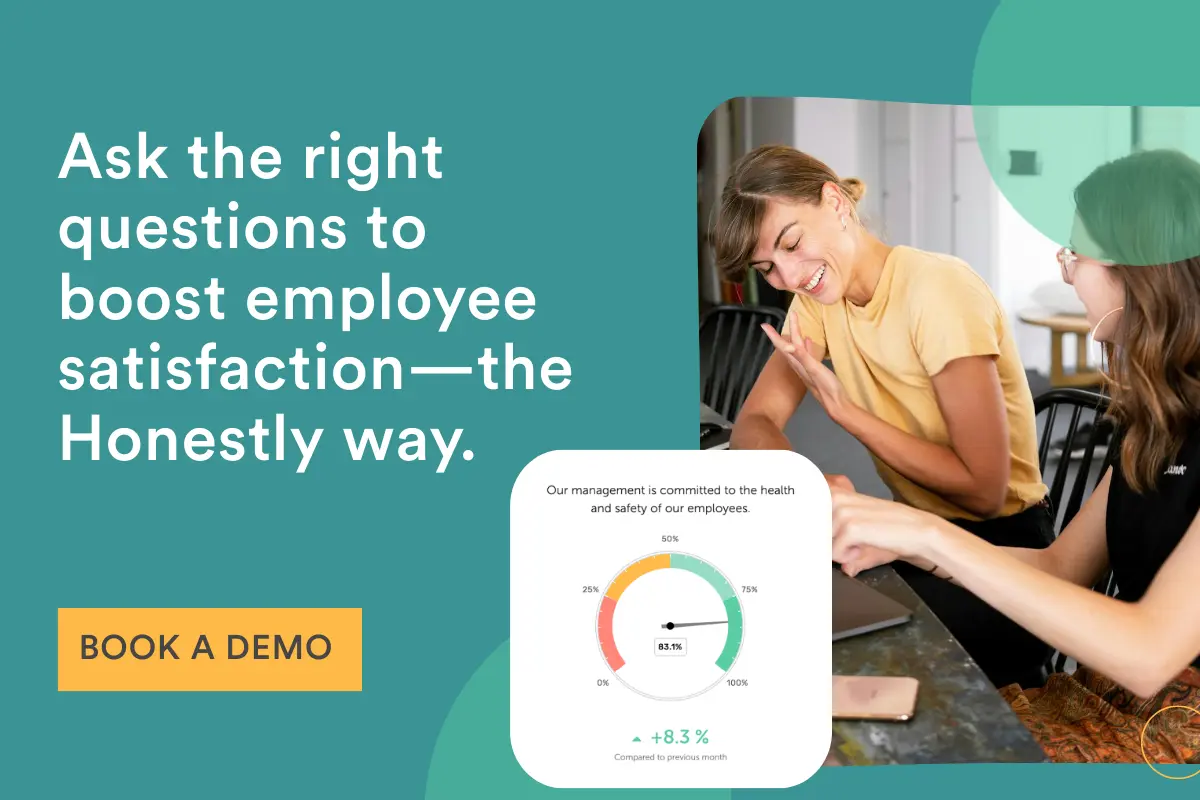The Ultimate Guide to Employee Pulse Surveys (+10 Questions)

Seeking real-time employee feedback? Pulse surveys are just what you need.
They help you stop a crisis before it happens instead of patching things up later.
In this guide, you’ll learn how to build and run employee pulse surveys the smart way.
We’ll also share 10 top survey questions we developed together with Freie Universität Berlin.
What Is a Pulse Survey?
Pulse surveys are quick, frequent questionnaires that gather immediate employee feedback.
They usually target specific, time-sensitive issues—such as measuring employee sentiment after introducing a company-wide change.
This approach contrasts with annual engagement surveys that analyze employee satisfaction over time.
For instance, a pulse survey might ask, “Do you feel your workload this week was manageable?”
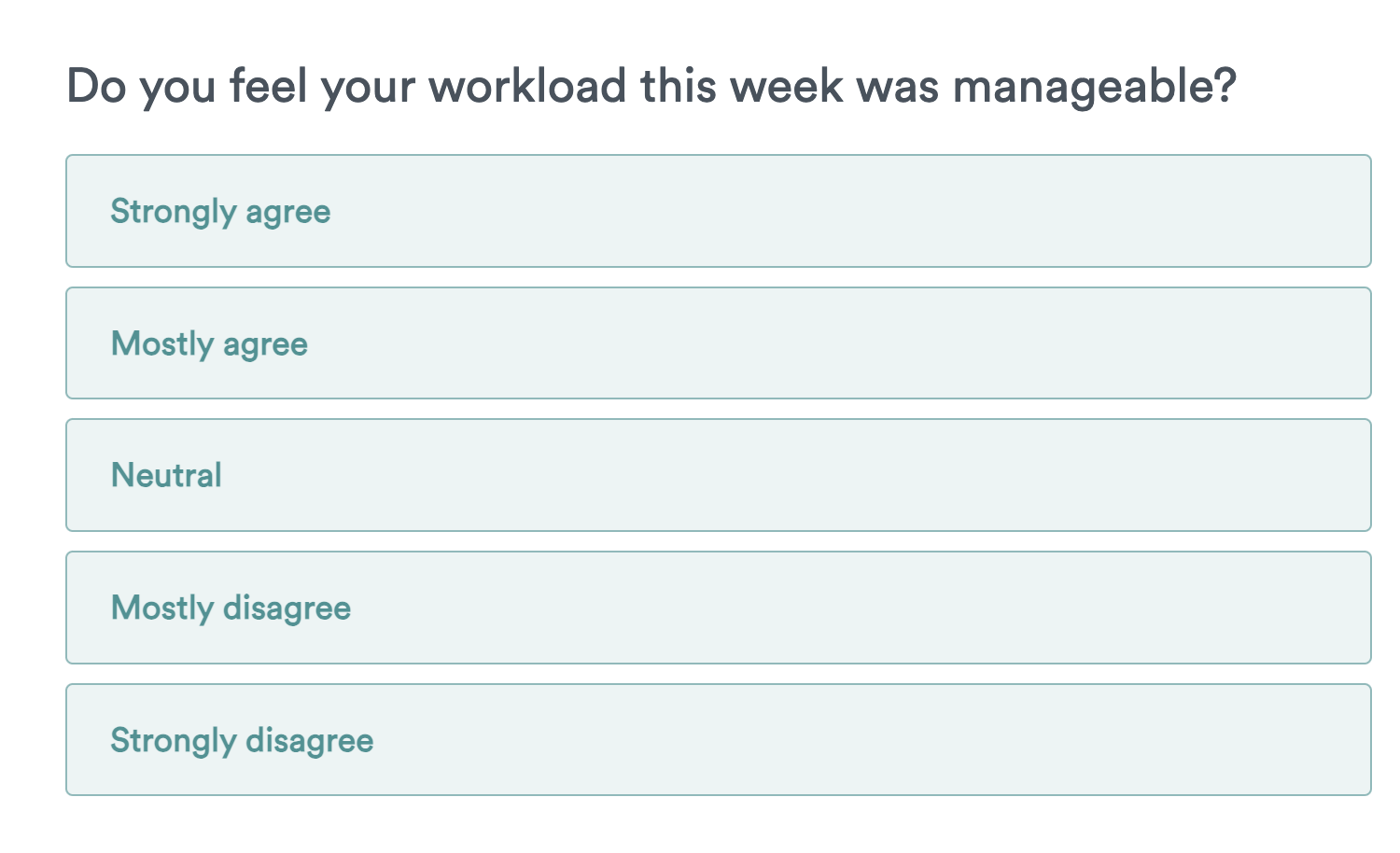
These questionnaires are particularly effective for capturing current employee feelings or opinions. You can then use them to boost workplace morale and productivity on the go.
Benefits of Pulse Surveys
Pulse surveys deliver quick insights and let you react with agility. Here’s why you should implement them on a regular basis:
- Real-time insights
These surveys let you analyze how corporate changes affect team morale and make informed decisions.
For example, you can check whether a new project management tool helps your employees or just increases their stress.
- Adding quick fixes
Use pulse surveys to quickly identify and address specific issues before they become more serious.
They’re usually short, and you’ll likely see a higher completion rate—while also reducing survey fatigue.
For instance, you might find out that a new workflow is causing bottlenecks and optimize it to avoid further costs.
- Spotting trends and correlations early on
Employee pulse surveys are also great for connecting the dots between what’s happening inside and outside your company.
They help you assess the general mood and pinpoint the causes of problems.
For example, a pulse survey can show if a new industry regulation is causing stress among your employees.
- Boosting workplace productivity
Pulse surveys create an ongoing feedback loop and give your employees a voice. Use them to validate important decisions, empower your teams, and act with agility.
Say you discover that your workers struggle with manual tasks: this insight can lead to adopting new automation tools.
Besides, employees who know they can drive real change in their companies are much more involved and productive.
How to Use Employee Pulse Surveys
There are a few use cases for running pulse surveys. For example:
- Collecting feedback: Assessing how new policies, tools, or initiatives resonate with your employees. You can also use pulse surveys to monitor changes introduced after annual employee surveys.
- Measuring engagement and satisfaction: Taking regular snapshots of employee engagement levels and overall mood to add necessary changes.
- Assessing cultural alignment: Analyzing whether your employees identify with the company’s culture and finding areas for reinforcement.
So, you can leverage pulse surveys in different ways depending on your current goals.
- For example, consider running regular pulse surveys to monitor engagement and conduct ad-hoc surveys after important company changes.
The 10 Best Pulse Survey Questions
Your pulse survey questions will vary depending on the context. For example, you might use them to evaluate the impact of a specific program or initiative.
However, there are a few effective ones you can integrate into your regular employee engagement pulse surveys.
Let’s explore some of the top pulse survey questions we designed in collaboration with FU Berlin.
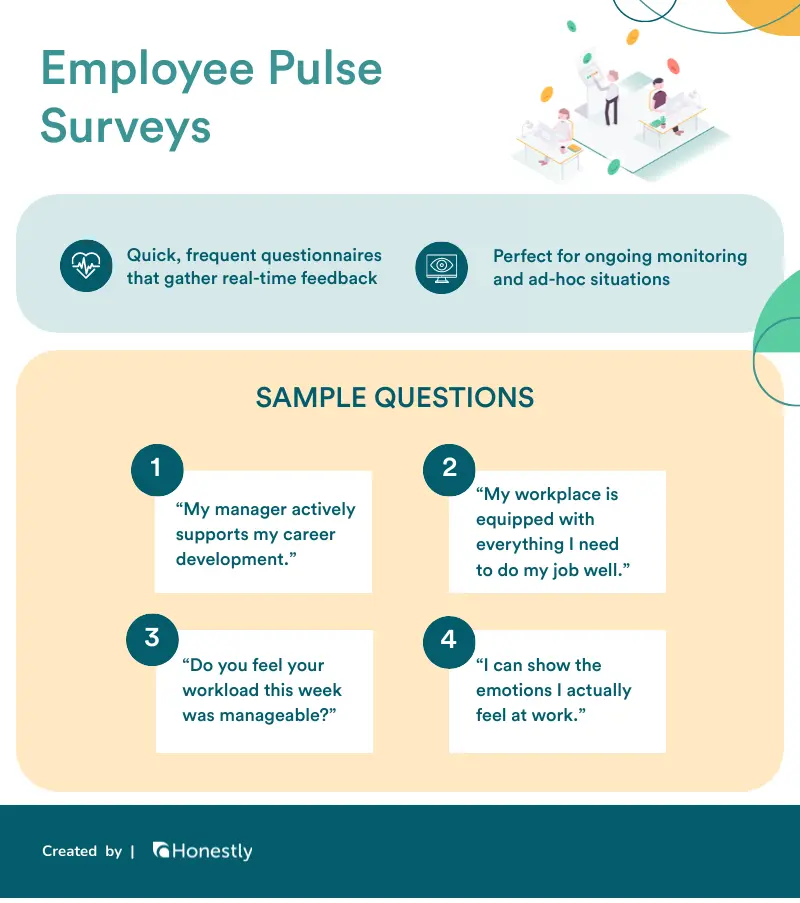
Questions About Management and Leadership
Leadership can make or break the team spirit. That’s why it’s so important to collect regular feedback on your employees’ views of their management.
You can use the Likert scale question type for such questions. Here’s how it looks:
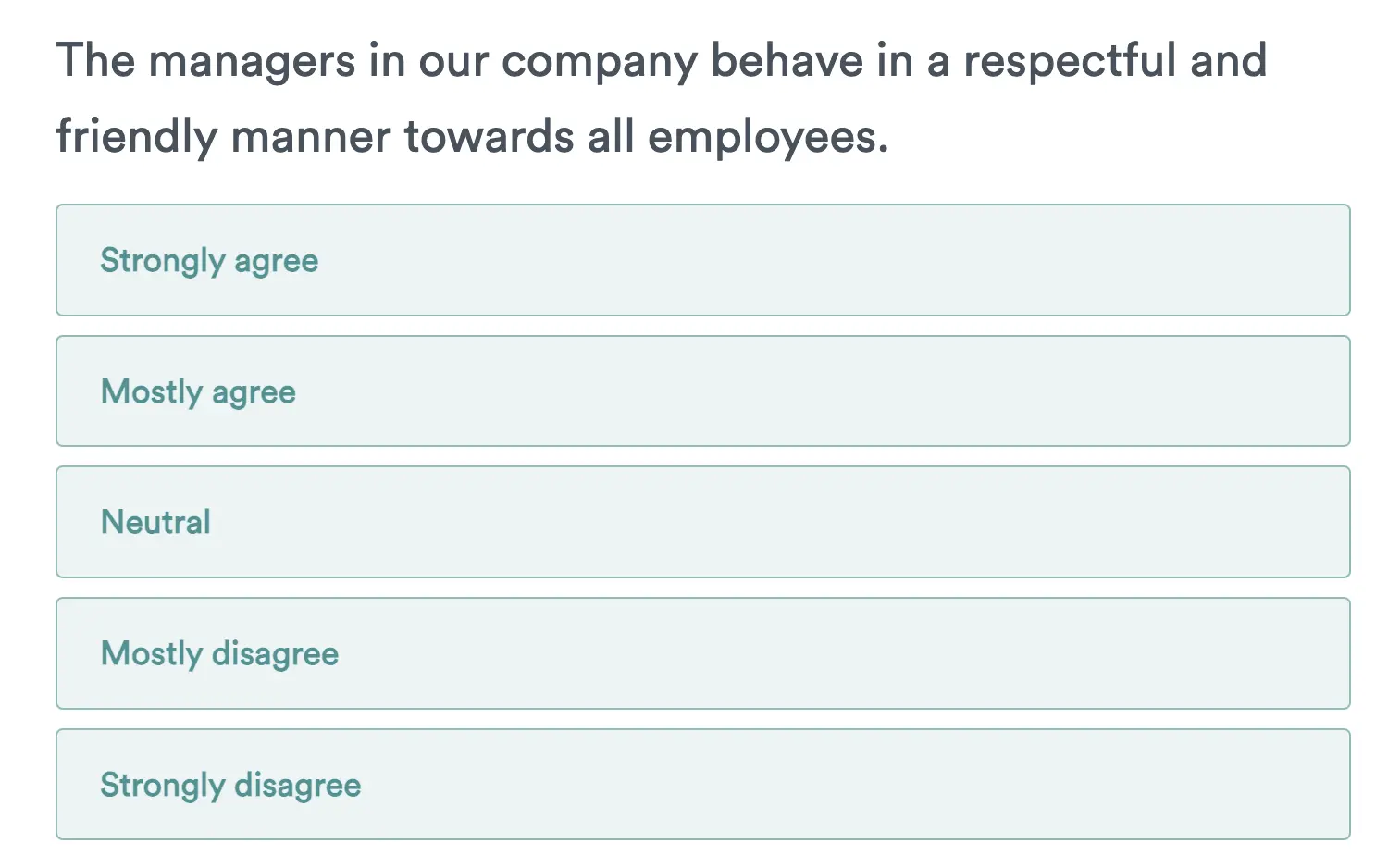
1. “The managers in our company behave in a respectful and friendly manner towards all employees.”
Asking this question lets you determine if your leaders are building a welcoming work environment. It ensures that everyone feels safe speaking up and sharing ideas.
2. “My manager actively supports my career development.”
This is a quick pulse check on whether employees feel supported in their professional ambitions.
Pro tip: Use Honestly’s pre-designed pulse survey template. It includes a complete list of scientifically validated questions—letting you set up pulse surveys with just a few clicks.
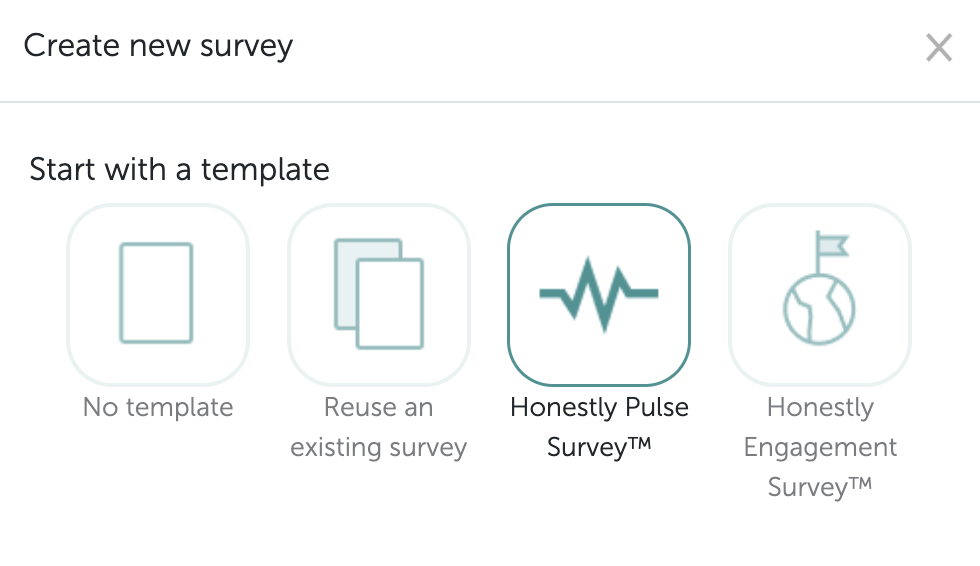
Questions About Job Satisfaction
Job satisfaction is rooted in stimulating tasks, using one’s skills effectively, and having the necessary resources.
Remember: satisfied employees typically perform better. Companies with high employee engagement report up to 23% higher profits compared to those with lower engagement levels.
3. “I am always given tasks that challenge me in a positive way.”
This helps you understand if employees find their work motivating and fulfilling.
4. “I can demonstrate my expertise and skills in my job.”
Ask this question to see if your workers feel that their abilities are being put to good use.
5. “My workplace is equipped with everything I need to do my job well.”
This checks if employees have all the tools they need—e.g., software, training, and office equipment.
Questions About Workplace Climate
These questions help you assess whether the work environment is open and supportive. It’s the only way to build a collaborative company culture based on trust.
6. “I can show the emotions I actually feel at work.”
This lets you check if your employees feel safe and comfortable being themselves, an essential part of a healthy workplace.
7. “There are many people at work who I can turn to if I need support.”
This question points to the strength of your team’s support system.
For instance, knowing there’s someone to turn to during challenging projects helps manage work-related stress.
Questions About Work-Life Balance
Work-life balance is essential for preventing burnout and boosting productivity. Regular pulse surveys help you monitor this metric and add changes before it’s too late.
8. “Do you feel your workload this week was manageable?”
This question checks if your employees are dealing with a healthy amount of work on a weekly basis. Use it to spot and address any immediate, ad-hoc workload issues.
9. “I can generally handle the amount of tasks I have to do well.”
You can also assess whether your employees feel capable of managing their tasks over time.
For example, if they consistently report feeling overwhelmed, consider introducing flexible work hours or optimizing the workload.
Open-Ended Questions
Including open-ended questions in your pulse surveys helps capture the nuances that pre-defined questions might miss.
This allows employees to share more detailed feedback, giving you deeper insights into their thoughts and feelings.
For example, ask:
10. “Is there anything else you would like to let us know? If so, please leave your comments here!”
You can also add open-ended questions for participants selecting negative responses (such as “Strongly Disagree”) on standard survey questions. For example:
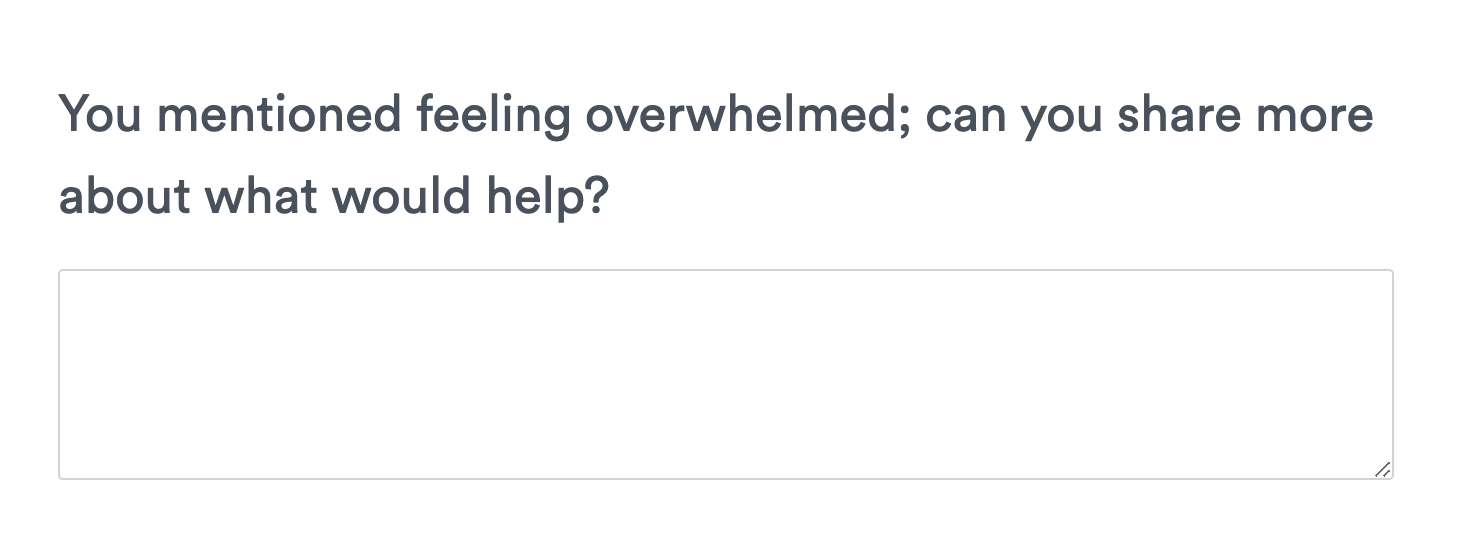
This way, you can quickly understand what’s wrong and add necessary fixes.
Pro tip:
Don’t want to analyze hundreds of responses for your open-ended questions?
Use employee survey tools like Honestly. It generates comprehensive AI summaries of all text feedback in your surveys.
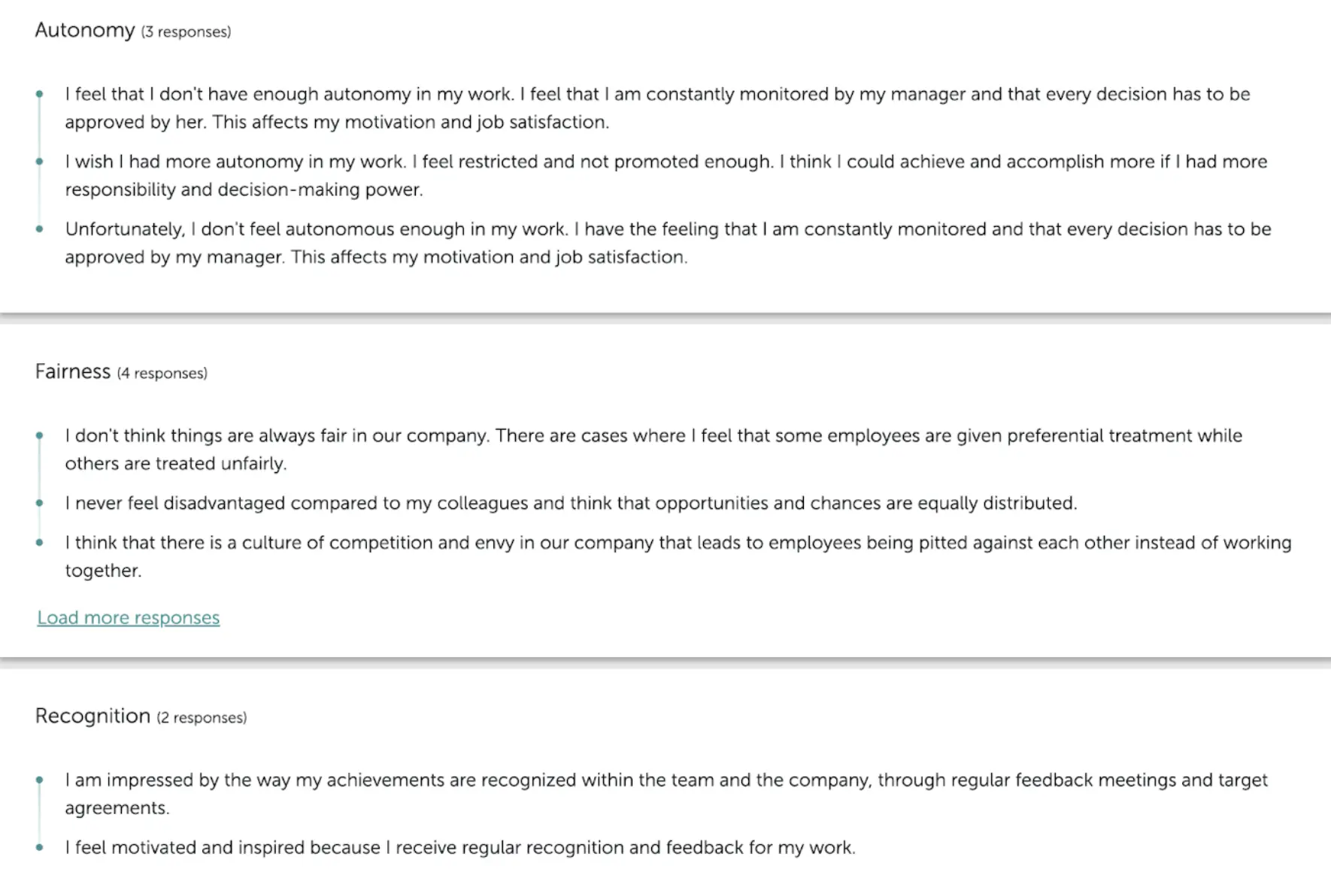
Employee Pulse Survey Best Practices
So, how do you design effective pulse surveys and gather useful data?
Let’s look at the most important steps to take.

1. Define clear objectives and stay focused
Don’t launch pulse surveys simply because you feel like you have to.
Instead, revisit your business goals and pinpoint areas that need improvement. For example, you might be dealing with low productivity and high employee churn.
Then, list your primary survey goals and decide what you’re trying to achieve.
Here are a few sample pulse survey objectives:
- Evaluate the general mood
- Track employee engagement
- Assess how employees feel about recent changes
- Validate a potential decision or initiative
- Find potential bottlenecks (e.g., what’s causing low productivity)
This way, you can prioritize questions that actually matter and act on your findings.
2. Use specialized pulse survey tools
Choose pulse survey software designed specifically for getting employee feedback. These tools come equipped with time-saving templates and robust analytics.
Here’s what you should consider:
- Ease of use
- Options for customization
- Pre-designed templates with validated questions
- Analytics dashboards
- Enhanced survey anonymity
This way, you can spend less time preparing the survey and more time implementing changes.
For example, Honestly lets you set up pulse surveys in minutes and helps you analyze the results 5x faster.
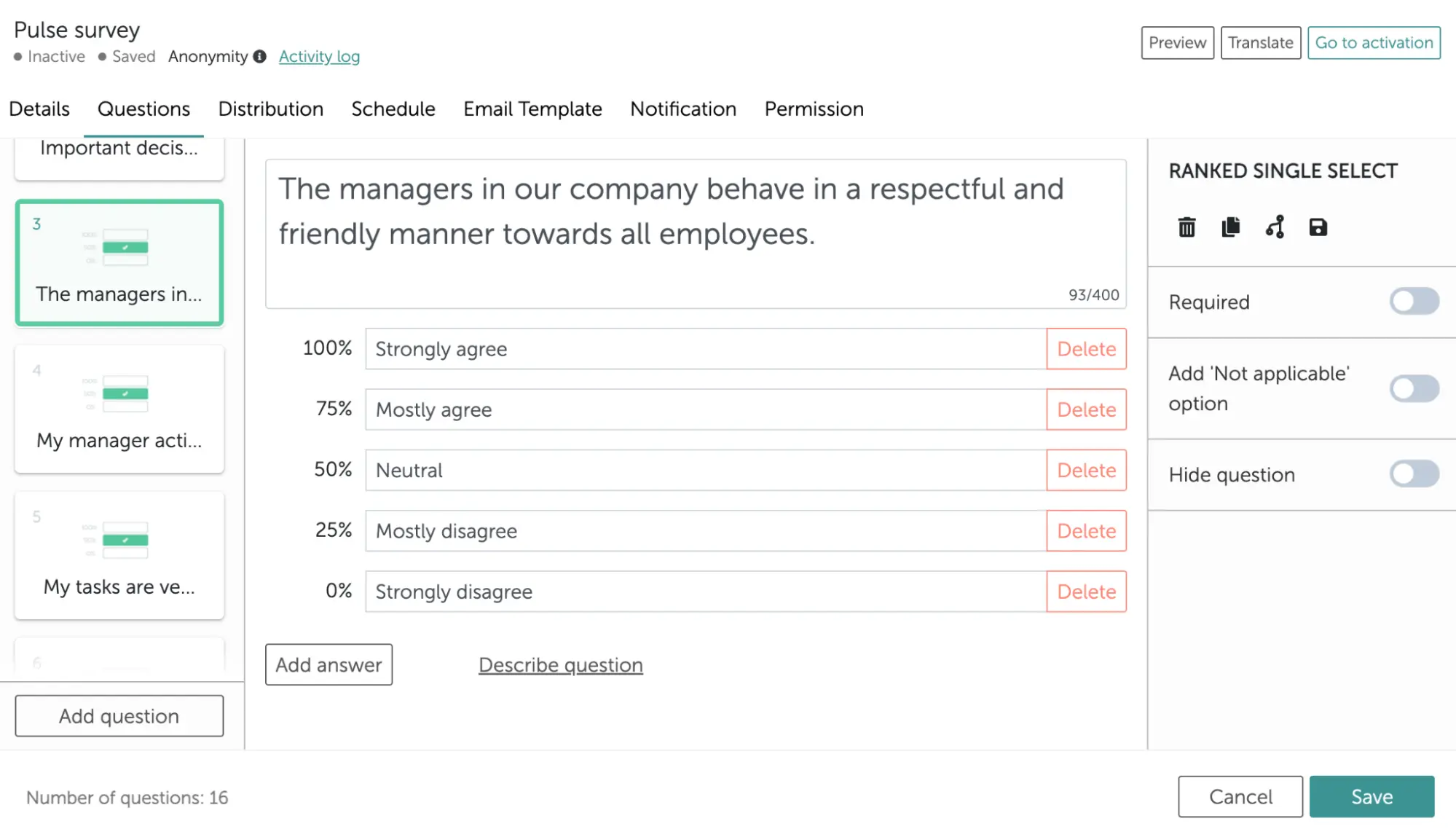
3. Keep your pulse surveys short
Pulse surveys are quick and simple by definition. So, make sure to keep them this way.
It’s important to choose questions that directly contribute to achieving your goals.
When designing your survey flow, ask yourself: What actionable insights can this question generate?
If there’s no clear answer, perhaps you should remove it from the list.
4. Make your questions clear and concise
Clarity and brevity are your best friends when writing pulse survey questions.
Well-phrased, specific questions help you avoid confusion and increase survey completion rates.
It’s also important to guarantee anonymity and remove questions that might make your employees feel uneasy.
Let’s look at a few examples:
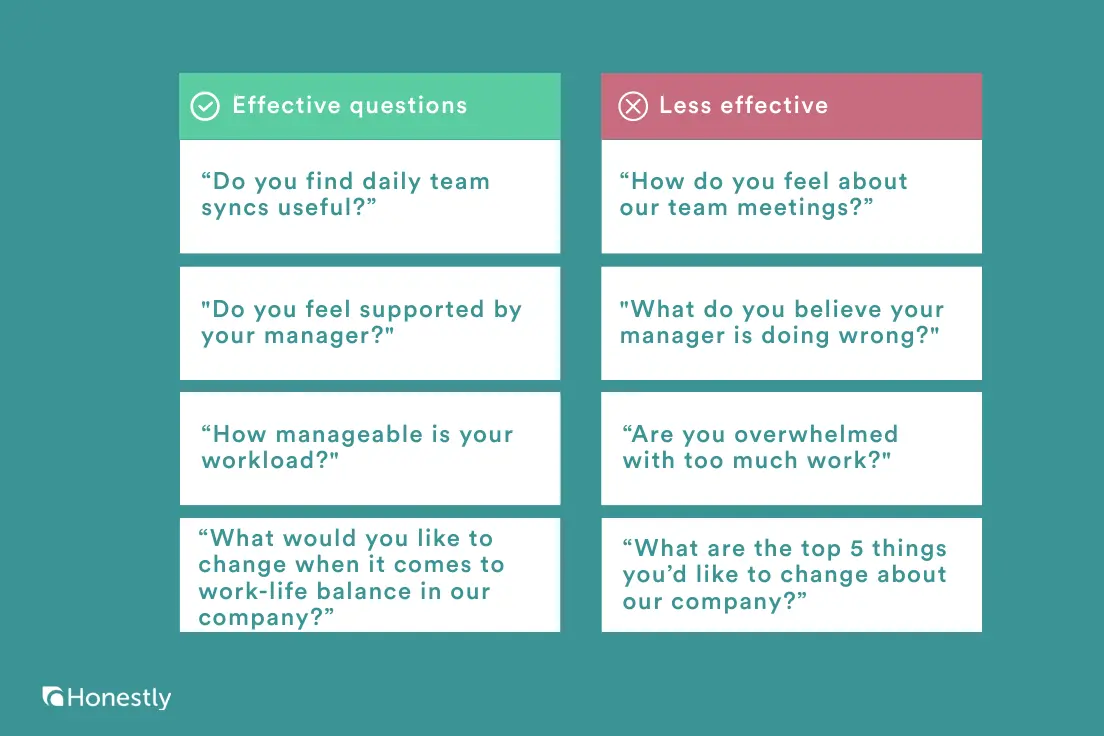
5. Create an effective communication plan
Next, you need an effective survey distribution strategy to maximize participation. Here are a few things to consider:
- Announce your survey in advance
- Explain the purpose of the survey
- Provide clear guidelines
- Use several channels: e.g., Slack, email, and a mention during a company-wide meeting
- Set a deadline
- Offer anonymity and confidentiality
This way, you’ll engage your employees and make survey participation as easy as it gets.
6. Act on your findings
Once you have the survey results ready, the real work begins.
Start by analyzing the data, then share these insights with your team and develop an action plan.
Open your survey results and take the following steps:
- Analyze the general trends and main findings
- Look for hidden data and outliers (e.g., one team showing much higher engagement)
- Connect your findings to your initial goals and design your plan
Would you like to automate these steps?
If you’re using Honestly, you can access all analytics dashboards and analyze your data in one place.
You can also create different views for various user roles across your company and customize them the way you want.
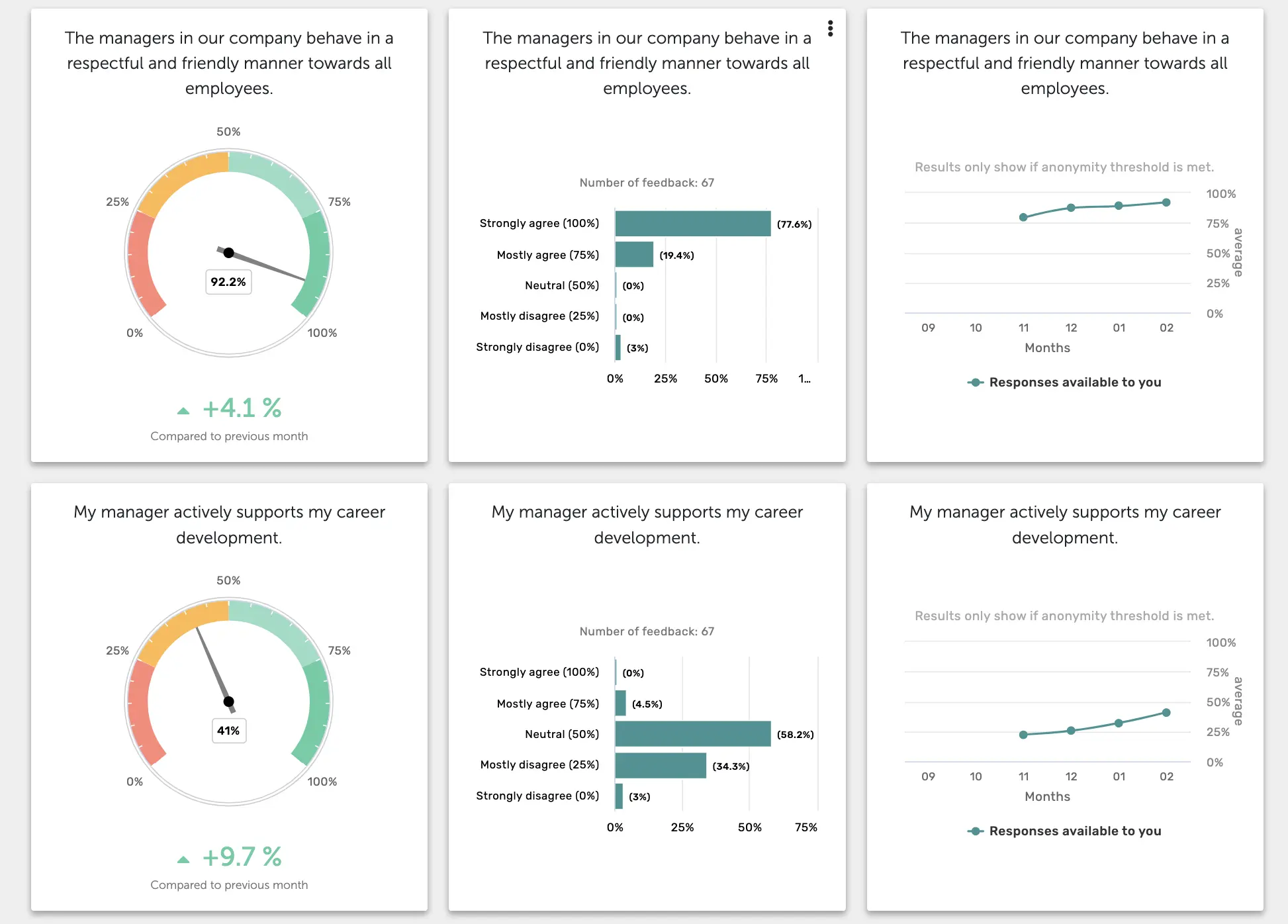
Next, use the heatmaps feature to dig deeper and save hours of data analysis.
For example, you can compare different periods, locations, teams, departments, and more.
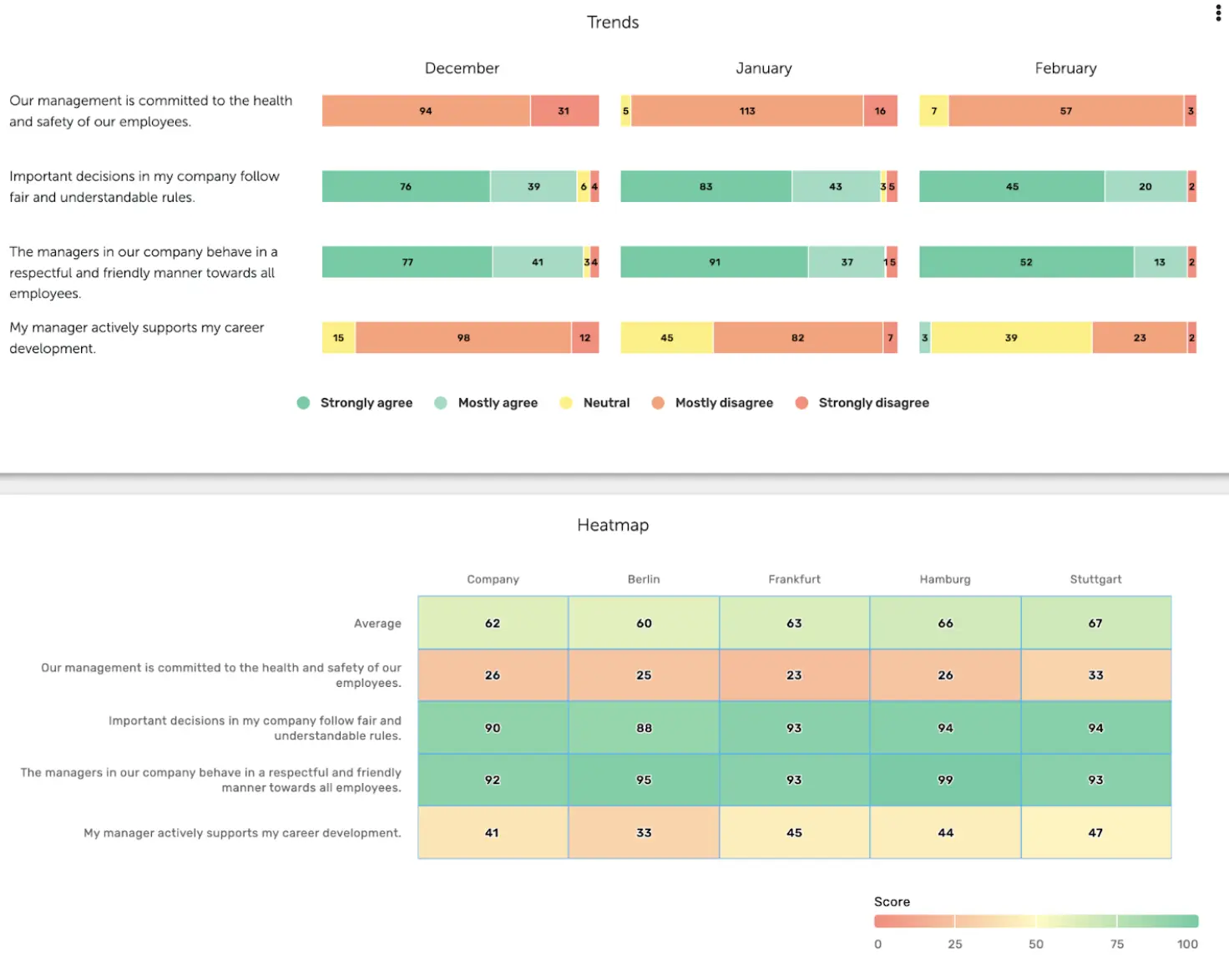
Once you’ve identified the key findings, think of ways to address them.
For example, if your pulse survey indicates declining work-life balance, it might be time to improve planning or hire new people.
7. Repeat, repeat, repeat
Pulse surveys need to be regular to be effective.
This helps you track progress over time and makes your entire people management strategy more data-driven.
Keep the cycle going: survey, act, and survey again.
FAQs About Pulse Surveys
Let’s unpack a few of the most popular questions about employee pulse surveys.
How Long Should a Pulse Survey Be?
The length of an employee pulse survey depends on how often it’s administered.
For instance, a monthly pulse might consist of 10-15 questions, while a quarterly pulse could have 15-20 questions. Bi-annual pulses sometimes extend to 20-30 questions.
The best approach is to focus on asking enough questions to reach your goals and removing repetitive, confusing questions that bring no value.
How Often Should You Run Pulse Surveys
The frequency of employee pulse surveys depends on several factors. For example:
- The context and your objectives
- Fluctuation of what you’re measuring
- Your company’s capacity to act on feedback
- The time needed to implement action plans
For instance, you can run quarterly pulse surveys for general tracking and plan the rest of them based on your current needs.
Pulse surveys vs engagement surveys
Pulse surveys and engagement surveys serve distinct purposes when analyzing employee sentiment.
Pulse surveys are short, frequent checks to quickly assess the current mood and gather immediate feedback.
Engagement surveys are more comprehensive, conducted less frequently, and dive deeply into employee satisfaction and engagement over time.
Here’s a brief comparison:
Pulse surveys:
- Regular (weekly, monthly)
- Usually short (5-15 questions)
- Focus on specific or immediate issues
- Reveal actions that need to be addressed quickly
Engagement surveys:
- Less frequent (annually, bi-annually)
- Long (50-100 questions)
- Analyze general engagement and job satisfaction
- Involve long-term strategic planning
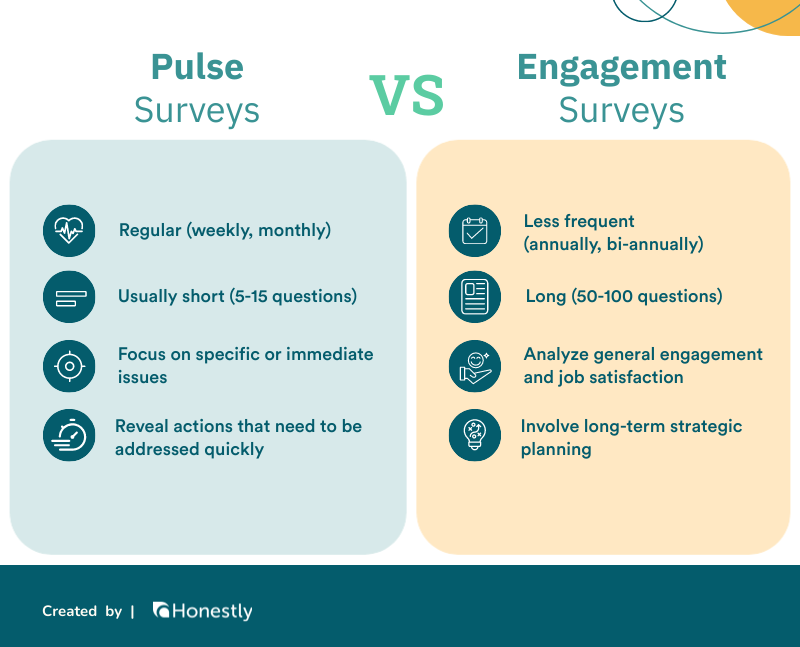
Create Pulse Surveys that Move the Needle
Pulse surveys are powerful tools for gathering real-time feedback. They allow you to quickly address emerging issues and keep your employees engaged.
Here’s how to make them more effective:
- Conduct them regularly
- Start with clear objectives tied to your business goals
- Design concise surveys with clear questions
- Analyze the data and look for hidden insights
- Always act on your findings
- Use a specialized employee survey tool
Ready to jump in?
Honestly’s got you covered with its pulse survey template and easy (yet powerful) analytics.


